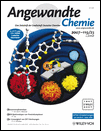Inducing and Sensing Protein–Protein Interactions in Living Cells by Selective Cross-linking†
This work was supported by the Swiss National Science Foundation, the Human Frontier Science Program, and the Boehringer–Ingelheim Foundation. We thank Thomas Gronemeyer for technical assistance and Nils Johnsson, Helen O'Hare, and Arnaud Gautier for discussions.
Graphical Abstract
Zellentechnik: Kleine Moleküle, die die kovalente und irreversible Dimerisierung von Fusionsproteinen der O6-Alkylguanin-DNA-Alkyltransferase (AGT oder SNAP-Tag) in vitro und in lebenden Zellen ermöglichen, wurden synthetisiert. Die Effizienz, mit der die AGT-Fusionsproteine vernetzt werden, ist ein Maß für die Nähe und die Wechselwirkungen von Proteinpaaren in lebenden Zellen (siehe Schema).





